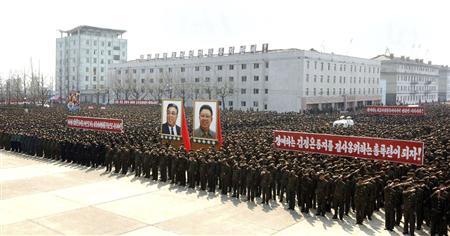
The United States said it would soon send a missile defense system to Guam to defend it from North Korea, as the US military adjusts to what Defense Secretary Chuck Hagel called a "real and clear danger" from Pyongyang.
Hours later, South Korea's Yonhap news agency said North Korea had moved what appeared to be a mid-range Musudan missile to its east coast. It was not clear if the North planned to fire the rocket or was just putting it on display as a show of force, one South Korean government source was quoted as saying.
North Korea also barred entry to a joint industrial complex it shares with the South for a second day on Thursday and said it would shut the zone if Seoul continued to insult it.
Events on the Korean peninsula have begun to unnerve global financial markets long used to the rhetoric North Korea routinely hurls at Seoul and Washington.
"The assumption remains that this is more bluster …," said Rob Ryan, a strategist with RBS in Singapore. "But from here, we've reached a level of tensions that say things can't get too much worse without an actual exchange of fire."
The broadest index of Asia-Pacific shares outside Japan was down 0.6 percent, dragged down by a 2 percent slump in South Korean shares, while the South Korean won slid 0.7 percent against the US dollar.
US stocks sank on Wednesday after Hagel's comments and the Guam deployment news.
North Korea also repeated its threat to launch a nuclear attack on the United States. Pyongyang said it had ratified a potential strike because of US military deployments around the Korean peninsula that it claimed were a prelude to a possible nuclear attack on the North.
Washington had been informed of the potential attack by North Korea, a spokesman for its army said in a statement carried by the English-language service of state news agency KCNA. It was unclear how such a warning was given since North Korea does not have diplomatic ties with Washington.
The report from KCNA appeared to re-state many of the month-long fusillade of threats emanating from Pyongyang.
Experts say North Korea is years away from being able to hit the continental United States with a nuclear weapon, despite having worked for decades to achieve nuclear-arms capability.
North Korea has previously threatened a nuclear strike on the United States and missile attacks on its Pacific bases, including in Guam, a US territory in the Pacific.
Those threats followed new UN sanctions imposed on the North after it carried out its third nuclear test in February.
"Some of the actions they've taken over the last few weeks present a real and clear danger," Hagel told an audience at the National Defense University in Washington.
Despite the rhetoric, Pyongyang has not taken any military action and has shown no sign of preparing its 1.2 million-strong armed forces for war, the White House said on Monday.
That indicates its threats are partly intended for domestic consumption to bolster young leader Kim Jong-un ahead of celebrations marking the anniversary of the April 15 birthday of Kim Il-sung, the state's founder and the younger Kim's grandfather.
Caitlin Hayden, spokeswoman for the White House National Security Council, criticized the latest North Korean statement.
"It is yet another offering in a long line of provocative statements that only serve to further isolate North Korea from the rest of the international community and undermine its goal of economic development," Hayden said.
Hagel: Take threats seriously
Hagel said he had to take the threats seriously, language he has used in recent weeks as the United States has revamped its missile defense plans and positioned two guided-missile destroyers in the western Pacific.
The United States has also flexed its muscles during annual military drills with South Korea, flying two radar-evading stealth bombers on a first-of-its-kind practice bombing run over South Korea.
In the latest move, the Pentagon said it was deploying a Terminal High Altitude Area Defense (THAAD) system to Guam in the coming weeks. The THAAD system includes a truck-mounted launcher, interceptor missiles and an AN/TPY-2 tracking radar.
Last month, Hagel said the Pentagon would add 14 new anti-missile interceptors in Alaska and move ahead with the deployment of a second missile-defense radar in Japan.
Yonhap quoted multiple government sources privy to intelligence from US and South Korean authorities as saying North Korea had moved what appeared to be a Musudan missile to its east coast.
The missile is believed to have a range of 3,000 km (1,865 miles) or more, which would put all of South Korea and Japan in range and possibly also Guam. North Korea is not believed to have tested the Musudan mid-range missiles, according to most independent experts
South Korea's defense ministry declined to comment.
The missile was moved to the coast by train. The North has a missile launch site on its northeastern coast, which it has used to unsuccessfully test-fire long-range rockets in the past.
The Yonhap report did not say if the missile had been moved to the missile site.
The South Korean government said the North would allow 222 South Korean workers to leave the Kaesong industrial zone on Thursday. That would leave another 606 South Koreans in the complex. Seoul has urged its citizens to get out.
North Korea has threatened to shut the complex, one of the impoverished North's few sources of ready cash.
The industrial park, just inside the border with North Korea, has not formally stopped operations since it was inaugurated in 2000. It houses 123 companies and employs 50,000 North Koreans making cheap goods such as clothing.




